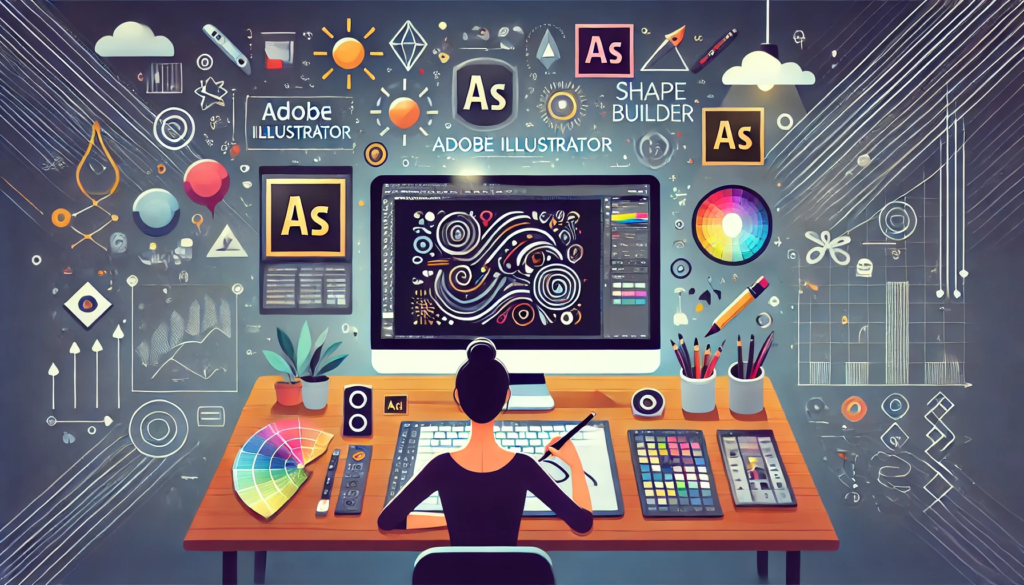Adobe Illustrator is a powerful vector graphics editor used by professionals for everything from logo design to complex illustrations. If you’re looking to elevate your graphic design projects, Illustrator is an essential tool that offers flexibility, precision, and creative freedom. Whether you’re a beginner or looking to improve your skills, this guide will help you understand how to use Adobe Illustrator effectively for your graphic design projects.
Getting Started with Adobe Illustrator
1. Understanding Vector Graphics
Illustrator is primarily a vector-based design tool. Unlike raster graphics, which are made up of pixels, vector graphics are created using mathematical equations, meaning they can be scaled infinitely without losing quality. This makes Illustrator ideal for creating logos, icons, typography, and other designs that need to be resized.
2. Familiarizing Yourself with the Interface
When you first open Adobe Illustrator, the interface can seem overwhelming. Here are the key components you’ll need to get started:
- Toolbar: Located on the left side, this contains tools like the Selection Tool, Pen Tool, Type Tool, and more.
- Control Panel: Found at the top, this displays options related to the currently selected tool.
- Artboard: The canvas where you create your designs.
- Layers Panel: Located on the right side, this helps you organize your design elements into different layers for easy management.
- Color and Swatches Panels: Also on the right side, these allow you to pick and save colors for your designs.
3. Creating a New Document
To begin, go to File > New and set up your document. Illustrator provides presets for different projects, like web, print, or mobile, but you can also create a custom document by specifying the size, units, and color mode (RGB for digital, CMYK for print).
Essential Tools for Graphic Design Projects
1. Selection Tool
The Selection Tool (V) is one of the most frequently used tools in Illustrator. It allows you to select, move, and resize objects on your artboard. The Direct Selection Tool (A) lets you modify individual anchor points, offering more control over your shapes.
2. Pen Tool
The Pen Tool (P) is the cornerstone of vector design. It allows you to create custom shapes by drawing paths, which are made up of anchor points and handles. Mastering the Pen Tool is essential for creating detailed logos, illustrations, and icons.
How to Use the Pen Tool:
- Click to create a straight anchor point.
- Click and drag to create a curved anchor point.
- Close the path by clicking on the original anchor point.
3. Shape Tools
Illustrator offers a range of shape tools like the Rectangle Tool, Ellipse Tool, and Polygon Tool, which are great for creating basic shapes that can be customized. You can adjust their size, color, and stroke in the Properties Panel.
Tip: Hold down the Shift key while creating shapes to maintain perfect proportions, like creating a square or a circle.
4. Type Tool
The Type Tool (T) allows you to add text to your design. Illustrator’s typography tools are highly versatile, allowing you to customize fonts, kerning, leading, and alignment. You can also create text on a path, which is ideal for logos or badges.
Tips for Working with Text:
- Use Type on a Path to curve text along shapes.
- Convert text to outlines (Type > Create Outlines) to turn it into a vector shape that can be edited like any other object.
5. Color Picker and Swatches
Color plays a crucial role in graphic design. Use the Color Picker to select colors manually or input specific color codes. The Swatches Panel allows you to save frequently used colors for consistency across your design projects.
Working with Gradients: Illustrator also has a Gradient Tool for adding color transitions. You can apply linear or radial gradients, adjust the direction, and tweak colors for unique effects.
6. Layers Panel
Layers are crucial for organizing complex designs. The Layers Panel allows you to separate different elements of your design, making it easier to work on individual parts without affecting others.
Pro Tip: Lock or hide layers when working on other sections to avoid accidental edits.
Creating a Logo in Adobe Illustrator
Now that you’re familiar with the essential tools, let’s walk through creating a basic logo:
Step 1: Create Basic Shapes
Start by using the Shape Tools (Rectangle, Ellipse, Polygon) to create the base of your logo. You can combine and adjust these shapes using the Pathfinder Panel to create more complex designs. The Pathfinder allows you to unite, subtract, and intersect shapes to create unique forms.
Step 2: Add Text
Use the Type Tool to add the brand name or initials to your logo. Adjust the font, size, and color as needed. Remember to choose a font that aligns with the brand’s personality (e.g., bold for tech, elegant for luxury).
Step 3: Apply Colors
Once your shapes and text are in place, apply your brand’s color palette. Use the Swatches Panel to save your color choices, ensuring consistency throughout your project.
Step 4: Finalize and Export
When you’re happy with your logo, save the file in multiple formats for different uses. Go to File > Export and choose from options like:
- PNG for web and digital use (transparent background).
- SVG for scalable vector use (ideal for responsive websites).
- EPS for printing.
Advanced Techniques in Illustrator
1. Using the Pen Tool for Custom Paths
If you want to create custom shapes or illustrations, the Pen Tool is your best friend. It may take time to master, but it allows you to draw anything from simple icons to intricate illustrations.
Pro Tip: Practice by tracing over images or shapes to get comfortable with anchor points and curves.
2. Pathfinder Tool
The Pathfinder Tool is perfect for combining shapes in creative ways. You can merge, subtract, and intersect shapes to create custom logos, icons, or even letterforms.
Common Pathfinder Options:
- Unite: Combines multiple shapes into one.
- Minus Front: Subtracts the front shape from the back shape.
- Intersect: Keeps only the areas where the shapes overlap.
3. Working with Artboards
Illustrator allows you to create multiple Artboards in a single document. This is useful for designing multiple versions of a logo or working on different sections of a project in one place.
Tips for Artboards:
- Use the Artboard Tool to create and manage multiple artboards.
- Organize different design variations on separate artboards for easy comparison.
4. Image Tracing
If you want to turn a raster image (like a photo or sketch) into a vector graphic, Illustrator’s Image Trace tool is invaluable. Simply import your image, select it, and go to Object > Image Trace to convert it to a vector format.
Settings: Adjust the tracing settings to fine-tune how Illustrator converts the image, balancing between detail and simplicity.
Exporting and Saving Your Work
Once your design is complete, it’s important to export it correctly depending on its intended use:
- PNG/JPEG: For web or digital use, export as PNG (with transparent background) or JPEG (for non-transparent images).
- SVG: Scalable Vector Graphics are great for responsive web design, ensuring your designs look sharp at any size.
- EPS: This format is ideal for high-quality printing and retains the vector properties of your design.
How to Export
- Go to File > Export > Export As.
- Select the desired file format.
- Set the resolution to 72 PPI for digital use, and 300 PPI for print.
Conclusion
Adobe Illustrator is an incredibly powerful tool for graphic designers. From creating logos to designing complex illustrations, the software’s extensive range of tools and features allows for unlimited creativity. By mastering the basics—such as the Pen Tool, Type Tool, and Pathfinder—along with learning advanced techniques, you can handle virtually any graphic design project with ease.
As you gain more experience, experiment with different tools, explore Illustrator’s extensive library of effects, and incorporate more complex techniques to take your designs to the next level. Whether you’re working on branding, web design, or print materials, Adobe Illustrator provides all the resources you need to create professional and impactful designs.
Frequently Asked Questions (FAQ)
1. What is Adobe Illustrator used for?
Adobe Illustrator is primarily used for creating vector graphics. It’s widely used by graphic designers for projects like logo design, illustrations, typography, icons, and infographics.
2. Is Adobe Illustrator good for beginners?
Yes, Adobe Illustrator is beginner-friendly with a bit of practice. The learning curve might be steep at first, but there are plenty of tutorials and resources available to help beginners get started.
3. What’s the difference between Illustrator and Photoshop?
The main difference is that Illustrator is vector-based, making it ideal for scalable graphics like logos, while Photoshop is raster-based, best for photo editing and pixel-based designs.
4. Can I create logos in Illustrator?
Absolutely! Illustrator is one of the best tools for creating logos due to its precision and scalability. Logos created in Illustrator can be resized infinitely without losing quality.
5. What file formats can I export from Illustrator?
Illustrator supports a variety of export formats, including PNG, JPEG, SVG, PDF, and EPS. Each format is suited for different uses, from web to print.

